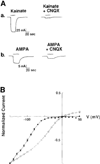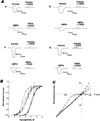A family of glutamate receptor genes: evidence for the formation of heteromultimeric receptors with distinct channel properties
- PMID: 1699567
- PMCID: PMC4481242
- DOI: 10.1016/0896-6273(90)90212-x
A family of glutamate receptor genes: evidence for the formation of heteromultimeric receptors with distinct channel properties
Abstract
We have isolated two cDNA clones (GluR-K2 and GluR-K3) that share considerable sequence identity with the previously described glutamate receptor subunit, GluR-K1. The three glutamate receptor subunits show significant sequence conservation with the glutamine binding component of the glutamine permease of E. coli. Each of these clones encodes a channel responsive to both kainate and AMPA. The coexpression of GluR-K2 with either GluR-K3 or GluR-K1 results in the formation of channels whose current-voltage relationships differ from those of the individual subunits alone and more closely approximate the properties of kainate receptors in neurons. These observations indicate that the kainate/quisqualate receptors are encoded by a family of genes and are likely to be composed of hetero-oligomers of at least two distinct subunits.
Figures





Similar articles
-
A glutamate receptor channel with high affinity for domoate and kainate.EMBO J. 1992 Apr;11(4):1651-6. doi: 10.1002/j.1460-2075.1992.tb05211.x. EMBO J. 1992. PMID: 1373382 Free PMC article.
-
Molecular cloning and development analysis of a new glutamate receptor subunit isoform in cerebellum.J Neurosci. 1992 Mar;12(3):1010-23. doi: 10.1523/JNEUROSCI.12-03-01010.1992. J Neurosci. 1992. PMID: 1372042 Free PMC article.
-
Agonist-activated cobalt uptake identifies divalent cation-permeable kainate receptors on neurons and glial cells.Neuron. 1991 Sep;7(3):509-18. doi: 10.1016/0896-6273(91)90302-g. Neuron. 1991. PMID: 1716930
-
AMPA-type glutamate receptors--nonselective cation channels mediating fast excitatory transmission in the CNS.EXS. 1993;66:61-76. doi: 10.1007/978-3-0348-7327-7_4. EXS. 1993. PMID: 7505664 Review.
-
Ligand-gated ion channels in the brain: the amino acid receptor superfamily.Neuron. 1990 Oct;5(4):383-92. doi: 10.1016/0896-6273(90)90077-s. Neuron. 1990. PMID: 1698394 Review. No abstract available.
Cited by
-
Cloning of an apparent splice variant of the rat N-methyl-D-aspartate receptor NMDAR1 with altered sensitivity to polyamines and activators of protein kinase C.Proc Natl Acad Sci U S A. 1992 Oct 1;89(19):9359-63. doi: 10.1073/pnas.89.19.9359. Proc Natl Acad Sci U S A. 1992. PMID: 1409641 Free PMC article.
-
Protein-protein coupling/uncoupling enables dopamine D2 receptor regulation of AMPA receptor-mediated excitotoxicity.J Neurosci. 2005 Apr 27;25(17):4385-95. doi: 10.1523/JNEUROSCI.5099-04.2005. J Neurosci. 2005. PMID: 15858065 Free PMC article.
-
A functional-phylogenetic classification system for transmembrane solute transporters.Microbiol Mol Biol Rev. 2000 Jun;64(2):354-411. doi: 10.1128/MMBR.64.2.354-411.2000. Microbiol Mol Biol Rev. 2000. PMID: 10839820 Free PMC article. Review.
-
Glutamatergic Signaling in the Central Nervous System: Ionotropic and Metabotropic Receptors in Concert.Neuron. 2018 Jun 27;98(6):1080-1098. doi: 10.1016/j.neuron.2018.05.018. Neuron. 2018. PMID: 29953871 Free PMC article. Review.
-
Glutamate receptor subtype expression in human postmortem brain.J Mol Neurosci. 1993 Winter;4(4):263-75. doi: 10.1007/BF02821558. J Mol Neurosci. 1993. PMID: 7917835
References
-
- Ames GF-L. Bacterial periplasmic transport systems: structure, mechanism, and evolution. Annu. Rev. Biochem. 1986;55:397–425. - PubMed
-
- Chomczynski P, Sacchi N. Single-step method of RNA isolation by acid guanidinium thiocyanate-phenol-chloroform extraction. Anal. Biochem. 1987;162:156–159. - PubMed
-
- Christie MI, North RA, Osborne PB, Douglass J, Adelman JP. Heteropolymeric potassium channels expressed in Xenopus oocytes from cloned subunits. Neuron. 1990;4:405–411. - PubMed
Publication types
MeSH terms
Substances
Associated data
- Actions
- Actions
Grants and funding
LinkOut - more resources
Full Text Sources
Other Literature Sources
Molecular Biology Databases

